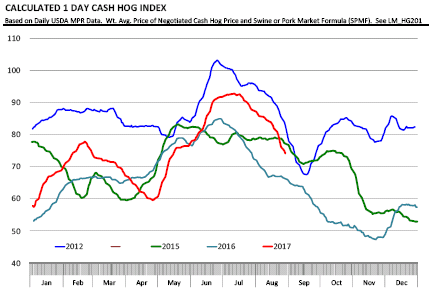



CME: Hog Slaughter Expected to be Large This Week
US - Cash hog prices have come under significant pressure in the last couple of weeks due to a combination of seasonally higher hog numbers and a changing retail picture for pork bellies, reports Steiner Consulting Group, DLR Division, Inc.
In our report on 21 August, we noted the dramatic increase in retail bacon prices and the decline in pork retail features. Since then packers have had to significantly lower belly prices in order to keep the product flow moving. How much has the decline in bellies impacted this market?
Consider that at the end of July the pork belly primal was valued at $212/cwt, more than double what it was the previous year. Last night USDA quoted the belly primal value at $128/cwt, a whopping $84/cwt (-40 per cent) decline in a matter of 4 weeks.
Most of the decline happened in the last 10 days. The decline in the value of bellies has accounted for almost all the decline in the pork cutout. The cutout was quoted last night at $84.55/cwt, $15/cwt less than a month ago and lower belly prices account for $13.5 out of that $15 decline.
While hog slaughter may be a bit less than was projected by the USDA June hog inventory report, the number of hogs coming through is significantly higher than it was back in July and it is expected to be even larger still in September and October.
For week ending 29 July, hog slaughter was 2.234 million hogs while last week slaughter was 2.344 million and we expect slaughter will likely be just as large this week as well. While pork demand has been quite good so far this year, there is no escaping the fact that there are plenty of hogs on the ground and they will all compete for shackle space in the next few months.
Slaughter declines during Labor Day week as packers are not able to make up the lost Monday production on the weekend. Last year in the four weeks following the Labor Day weekend hog slaughter averaged 2.430 million hogs and this year we will surely surpass those numbers. It’s a bit of a puzzle as to what kind of increase we will get in September.
Based on recent trends (last four weeks), we could see slaughter up at least 2.5 per cent from a year ago, which would put average weekly kill at around 2.490 million. However, if slaughter starts to approach the levels indicated in the June survey, then we could see average weekly slaughter in the 2.525 million area.
To be sure these kinds of numbers are not a surprise, market participants have been throwing around these calculations since spring. Higher than expected increase in pork prices during June and July seemed to put the fall supply pressures in the backburner.
The sharp deflation in belly prices was a reminder that strong as demand may be, both producers and packers still have to contend with all time record pork supplies. It’s a challenge that becomes even more daunting when there is also more beef and pork competing for the consumer dollar.

There are a couple of wild cards that will significantly impact what kind of hog prices we ultimately see in the last three months of the year. First, how quickly the new pork plants are able to ramp up production.
Last year the meat margin was dramatically higher in the fall as packers needed to run extra shifts on weekends and had to be compensated accordingly. This year producers are counting on those two new plants to absorb some of the additional hogs in the pipeline.
While strong demand may keep the cutout in the mid 70s, availability of shackle space will determine how big the meat margin needs to be to get hogs processed in a timely fashion. Second, weights are moving higher. It will be imperative for producers to continue to market hogs in a timely fashion.
It will make a big difference if carcass weights climb over 215 pounds in November vs. bringing hogs a couple of pounds lighter. The trajectory in hog weights and prices in 2015 and 2016 outlines two different scenarios in that regard.









